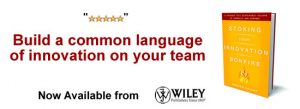To Innovate is to Choose
 Analogies are a powerful tool in an innovator’s arsenal. We use analogies to understand how other firms or other industries have solved a particular problem, and then evaluate that existing approach or solution in light of our challenges. Here’s an example. We were working with a firm that makes lawn mowers, and the goal was to improve the result of cutting your lawn. We wanted a smooth, even cut. One of the most significant aspects of a smooth cut is not under the control of the firm that makes the lawn mower: how sharp the blade is. That’s the responsibility of the owner, not the firm that made the mower, yet the blade sharpness drives a significant portion of the ultimate satisfaction of the lawn mower owner.
Analogies are a powerful tool in an innovator’s arsenal. We use analogies to understand how other firms or other industries have solved a particular problem, and then evaluate that existing approach or solution in light of our challenges. Here’s an example. We were working with a firm that makes lawn mowers, and the goal was to improve the result of cutting your lawn. We wanted a smooth, even cut. One of the most significant aspects of a smooth cut is not under the control of the firm that makes the lawn mower: how sharp the blade is. That’s the responsibility of the owner, not the firm that made the mower, yet the blade sharpness drives a significant portion of the ultimate satisfaction of the lawn mower owner.
So we asked ourselves, what analogies exist for keeping a frequently used blade sharp with minimal interaction from the owner? Clearly we could have the owner intentionally sharpen the blade, or create some self-sharpening device. But the analogy that seemed the most apt was from the razor blade companies. Couldn’t we create a “disposable” blade for a mower that could be used several times and then thrown away? Analogies make for great idea generation techniques.
The analogy for today is about the difficulty of innovating, because innovation forces a team to choose. The original statement is “to govern is to choose” which is variously attributed to JFK, Charles de Gaulle and others. The origin is less important than the meaning. This statement is meant to indicate that governments have the duty to allocate the funds they receive according to the decisions they believe will best affect the country. Some factions will receive funds, some won’t – the choice is part of governing.
Innovation has a very similar conundrum. There are always far more good ideas than the resources necessary to fund and develop the ideas. Therefore, idea selection is about making choices in the face of limited information which could be wrong in hindsight. That’s one of the first problems with innovation – we ask people to make hard choices with limited information about products or services that may, or may not, be successful. Innovation has another challenge to most executives when it comes to choice: innovation requires a very different set of commitments and choices than the status quo.
Imagine an existing product or service. The product manager is usually confronted with choices about color, or packaging or pricing. Relatively distinct choices that will have incremental impact to the existing product. Now consider a product manager or executive asked to make choices about a product that doesn’t yet exist. Every choice he or she makes is risky and uncertain. Most executives are uncomfortable in this situation and seek to limit options and choices, seeking clarity and safety, or at least consensus. This is why most “innovation” seem so bland. Once we remove risk from the equation and bring consensus into the equation, we’ve watered down the product or service to the point where it’s not innovative anymore.
The risks associated with the choices were too great initially, and the compromises made to avoid hard choices watered down the final product. To innovate is to choose, much like Chicago voting – early and often – often with poor data and only a gut intuition. Perhaps beggars can’t be choosers, but innovators must be.
Don’t miss a post (2,000+) – Subscribe to our RSS feed and join our Continuous Innovation group!
 Jeffrey Phillips is a senior leader at OVO Innovation. OVO works with large distributed organizations to build innovation teams, processes and capabilities. Jeffrey is the author of “Make us more Innovative”, and innovateonpurpose.blogspot.com.
Jeffrey Phillips is a senior leader at OVO Innovation. OVO works with large distributed organizations to build innovation teams, processes and capabilities. Jeffrey is the author of “Make us more Innovative”, and innovateonpurpose.blogspot.com.
NEVER MISS ANOTHER NEWSLETTER!
LATEST BLOGS
The Evil Downside of Gift Cards
This past holiday season I saw probably one too many articles trumpeting the value of gift cards to retailers and how they are a great thing for retailers. My skeptic side starts coming out as I see article after article appear, and I have to start asking “Is the increasing prevalence of gift cards as a holiday gift (primarily Christmas) a good thing for retailers?”
Read MoreWhy the iPhone will not succeed – Yet
The new Apple iPhone is set to launch on June 29, 2007 and the press and investors are making it a darling. Investors have run Apple’s stock price up from about $85 per share before its announcement to $125 per share recently, but the iPhone still will not succeed – at least not yet.
Read More



